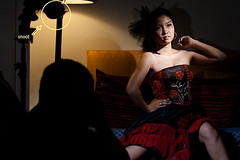 A snoot (click on the image on the left for a larger view) in many ways is similar to a grid in the sense that both restrict the light that’s coming off the source. This particular (usually tunnel-shaped) attachment allows you to control the part of the scene that is lit by focusing the light in the direction in which the snoot is pointed.
A snoot (click on the image on the left for a larger view) in many ways is similar to a grid in the sense that both restrict the light that’s coming off the source. This particular (usually tunnel-shaped) attachment allows you to control the part of the scene that is lit by focusing the light in the direction in which the snoot is pointed.This is one of the first attachments that I made myself using some illustration board, duct tape and hook-and-loop fasteners. A DIY project that led me to finding an alternate use for plastic placemats, and one that I would’ve happily continued if not for my wife’s sudden realization that our placemat numbers were dwindling.
‘Four? Didn’t we just have three of these?’
__________
 Again to create drama in a portrait, you must play light against shadow to create both contrast and tension. The inherent restriction of the beam coming off the flash will allow you to selectively light parts of the scene (or even the subject).
Again to create drama in a portrait, you must play light against shadow to create both contrast and tension. The inherent restriction of the beam coming off the flash will allow you to selectively light parts of the scene (or even the subject).In this environmental portrait of a student working in the lab, I used two snooted flashes to cross light the subject. Working at ISO 400 and shooting at 35 mm (on a crop body), an aperture of f/5.6 paired with a shutter speed of 1/100 s allowed the background to become underexposed. Aside from providing contrast, this allowed me to minimize the contribution from ambient light, which came from overhead fluorescent lamps (humming and unflattering light sources that they are).
__________
 In this classroom scene, I used a snooted flash propped high on a light stand on camera right. Shooting at 42 mm at ISO 400, an aperture of f/5.6 to keep the students behind the main subject (on the right) from falling out of focus and a shutter speed of 1/25 s allowed some of the ambient light to bleed through the scene. The effect of the snooted flash here is subtle (I hope) as I used it to highlight the student on the right to make her pop out of the frame. Also, the flash is gelled with a 1/4 CTO strip to bring out the warmth in the skin.
In this classroom scene, I used a snooted flash propped high on a light stand on camera right. Shooting at 42 mm at ISO 400, an aperture of f/5.6 to keep the students behind the main subject (on the right) from falling out of focus and a shutter speed of 1/25 s allowed some of the ambient light to bleed through the scene. The effect of the snooted flash here is subtle (I hope) as I used it to highlight the student on the right to make her pop out of the frame. Also, the flash is gelled with a 1/4 CTO strip to bring out the warmth in the skin.A snoot is definitely one of the cheapest ways to modify light coming from your hot shoe flash as you can easily make one with materials that are readily available. And it gives surprisingly great results, so think twice before you decide to dispose of your old plastic placemats.
I've been looking for this post since you changed the name of your blog. I just love the conversation you had with Susan regarding the dwindling numbers of placemats. :)
ReplyDelete